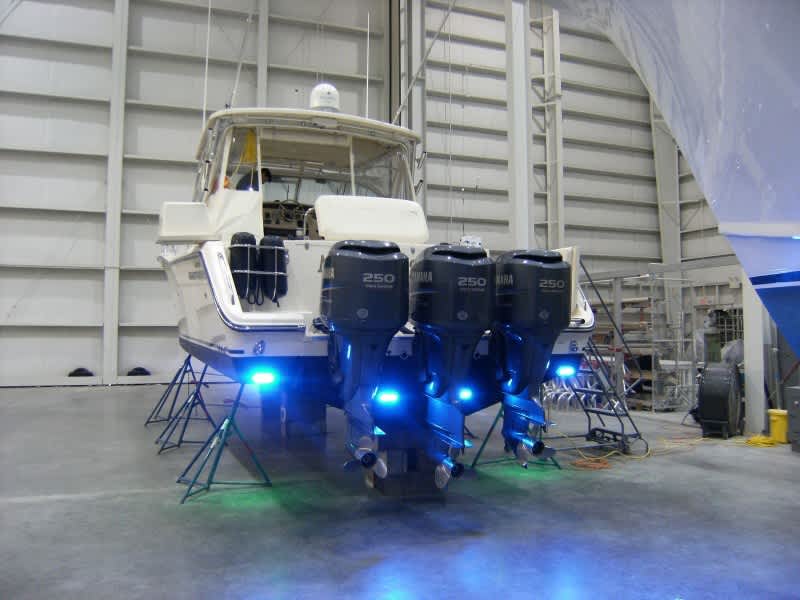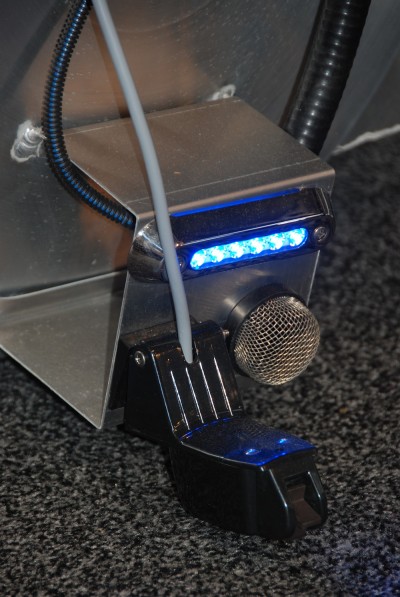Let There Be Underwater Light
Dan Armitage 01.27.14

Ever since Native Americans realized that using a blazing punk held over the water at night attracted fish within range of their spears, after-dark anglers in this country have been using some sort of light to “hook up” with their finned quarry.
Beyond illuminating the immediate surroundings and making it easier to do everything from tying knots to unhooking a catch, lights benefit nighttime anglers in several ways. Perhaps most important is the lights’ ability to attract food that fish seek.
After dark, a classic food chain begins to set up soon after light hits the water—from above or below—and starts to attract microscopic phytoplankton, which are followed by zooplankton and the baitfish that feed on both. Gamefish are never far behind their small-fry prey. If the light source is above the water, or submerged shallow enough to illuminate the area above the water’s surface, the light attracts flying insects as well, some of which fall into the water and attract both baitfish and gamefish that come to feed on the bugs.
A factor that is often overlooked by anglers is that light also creates shadow. Ambush predators that rely on stealth and cover to effectively feed prefer light and the shadowy edges it creates, not only around physical structure such as dock pilings, rocks, and deadfalls, but at the bitter-end of the light’s reach. Savvy night fishermen know that the largest gamefish are often found patrolling just beyond the edge of any available light, where they can see while remaining unseen, and these night anglers in-the-know direct their casts based on that knowledge.

The classic night fishing rig consists of a kerosene white-gas lantern hanging from a pole held out over the water from the side of an anchored boat, perhaps with a shade fashioned of tin or aluminum foil on one side to keep the light off the boat and occupants. The fishermen aboard bide their time until the light works its magic on the insects above and the plankton below, and break out their lines when they start hearing the splashing or seeing the flashing of feeding fish that have been attracted to the bright site.
It didn’t take long for fishermen to suffer the negative consequences of top-water lights’ insect-attracting qualities before lights that floated on the surface were developed to direct the fish-attracting rays down and into the water. Among the first floating fishing lights were those fashioned by fishermen using automobile headlamps set in inflated tire inner-tubes, Styrofoam blocks, or other buoyant material, the lamps powered by long wires attached to 12-volt batteries aboard the boat. Commercial versions of these simple, yet highly effective tools soon followed and are popular today.
Floating next to the boat, bridge or dock, the rigs keep the light and the bugs that follow off the anglers and direct a beam deep below the water to attract plankton and start the feeding chain.
More recently, as technology has allowed, totally-submersible lights have become available. There are models of portable fishing lights that sink down as far as the cord allows, and are plugged into 12-volt accessory receptacles and powered by the boat’s batteries.
Innovative anglers soon started experimenting with colored lights to see which hues were most effective at attracting the food that gamefish would follow to within casting range of their boats. So far, green has gotten the nod, especially among freshwater anglers, and there are a dozen versions of underwater fishing lights that emit an emerald glow. Saltwater anglers have been using lights colored blue, red, and even strobed versions of said colors in attempts to attract bait and the fish that follow. Even ice angers are getting into using lights to attract fish.
The latest fishing light technology involves the use of LED lights, rather than incandescent bulbs. The main advantage of LED lights is their long life; they can burn continuously for over a decade. LEDs also draw significantly less electricity than incandescent or even halogen lamps, and the heat that LED lights generate is emitted from the back of the light instead of through the front, so LEDs need not be submerged to avoid overheating and bursting the bulb.
However, submerged is just where the latest efforts in LED fishing lights are being found, especially on offshore fishing boats. Companies such as DeepSea Power & Light, OceanLED, and Attwood design LED fishing lights to be permanently set in the hulls of large craft. Some manufacturers of larger saltwater fishing craft are now offering built-in fishing lights as options.
In addition to the underwater lights’ fish-attracting qualities, there is a certain ambiance about a docked boat that appears to be afloat atop an aqua-blue aquarium—and many installations are intended for just such après-fishing purposes.

